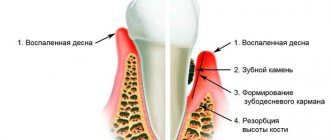1374
Stomatitis is one of the most unpleasant dental diseases. Moreover, it is extremely widespread.
Therefore, it is completely natural to want to find out whether this disease is dangerous for others, whether it can be contracted from another person . And if possible, how can you protect yourself and your family from stomatitis?
Aphthous
It is this variety that is the safest for others in the sense that in most cases it cannot be transmitted from a carrier .
Despite this, in case of possible contact with a person who has been diagnosed with aphthous stomatitis, it is better to take the necessary precautions:
- The fact is that sometimes this type of disease occurs against the background of various viral infections.
In this case, in addition to the likely appearance of aphthae (ulcers on the oral mucosa), there is also general redness and inflammation, especially in the throat area. With this etiology of aphthous stomatitis, others may become infected with the viral infection itself , since at a time when aphthae has already appeared, the initial infection can still be transmitted by airborne droplets, that is, by talking, sneezing, coughing, etc. - Another option when this variety will be contagious is in newborns and children up to six months with an initially traumatic route of occurrence . At this age, the mucosal defense mechanism, that is, local immunity in the oral cavity, does not yet work in children.
A large number of pathogens accumulate in the affected areas, which can be transmitted to another child through contact, for example, sharing toys, pacifiers, dishes and hygiene items. Therefore it is better to avoid this.
Symptoms of the disease
Many people confuse the symptoms of viral stomatitis with the symptoms of a common cold, and therefore begin self-treatment without even consulting a doctor. This is a fundamentally wrong decision, because in this way you are delaying the treatment of stomatitis, but this is not worth doing, because ulcers and wounds in the mouth can increase, thereby creating severe pain and discomfort when eating food. It is important to note that visible signs of stomatitis do not appear in the oral cavity immediately, which is why a person mistakenly believes that he just has a cold. So, let's take a closer look at the symptoms of the disease:
- Chills.
- Weakness.
- Bad dream.
- Headache.
- Loss of appetite.
- Inflammation of the gums.
- Irritability.
- Discomfort in the throat.
- Increase in temperature.
- Increased salivation.
A few days after the appearance of the above symptoms, blisters filled with liquid begin to form in the oral cavity, which, after they burst, become painful ulcers and can become covered with a film. The oral tissue around these wounds becomes inflamed and slightly swollen. Erosion may also appear, which is very itchy and painful. The rashes are localized on the mucous membranes of the cheeks, tongue and lips. They become crusty and sometimes even fester, creating a putrid odor from the mouth.
If you discover viral stomatitis in yourself or your child, do not delay visiting the doctor, because in especially severe cases, necrotic ulcers begin to form, that is, the affected tissues of the oral cavity die, which is very dangerous.
Viral
This variety is definitely contagious and quite dangerous for others , since it can be transmitted to a very large number of people in a fairly short period of time.
The disease is caused by several main types of viruses:
- adenoviruses;
- enteroviruses;
- herpes simplex;
- parainfluenza and influenza;
- chicken pox.
Next, we will talk about all types of viruses, except herpes, since there is a separately considered herpetic stomatitis, caused specifically by the herpes virus.
Can treatment with folk remedies for candidal stomatitis be an independent measure to combat the infection?
In a separate article we will talk about ways to get rid of white mouth sores.
Read the link https://www.vash-dentist.ru/lechenie/bolezni-polosti-rta/stomatit-bpr/samyie-populyarnyie-i-deystvennyie-mazi.html, for whom Metrogyl Denta ointment for stomatitis is recommended.
Routes of infection
Each of them is quite easily transmitted from the carrier to surrounding people. And not only for children, as many believe, but also for adults.
There are several different ways of contracting viral stomatitis , each of which is equally likely.
- Aerosol or airborne . That is, the main causative agent of the disease enters the body of others through the release of saliva or sputum along with moisture when coughing, sneezing, or exhaling air.
- Contact . During direct contact with an infected person, viruses can enter the skin or mucous membrane of another person through kisses, hugs, handshakes, etc.
- Household . This refers to the use of hygiene items, dishes, toys and other things shared with the patient.
- Internal , that is, through the blood.
The virus, in the process of activity, is, among other things, in the patient’s blood. Therefore, you can also become infected by direct contact of contaminated blood with a wound or affected mucous membrane, or if disinfection measures are insufficient before using scissors, razors, etc.
How long does the dangerous period last?
In order to subsequently take proper safety measures, it is very important to know how long the dangerous time for infection lasts, when it begins and ends.
On average, the disease lasts about a week (5 to 10 days). All this time it is believed that it is possible to get the disease from a carrier. When this period ends, that is, all symptoms and manifestations pass, in most cases the danger of infection disappears.
However, you should also remember about the preliminary period, which is called incubation . Despite the absence of main manifestations and symptoms, the disease is already beginning to develop and the carrier becomes potentially dangerous.
This period may vary depending on the specific type of virus. On average, it lasts five to seven days. However, sometimes it can last up to two weeks or more.
If we talk about newborn children and infants up to several months old, then the incubation period of viral stomatitis rarely lasts more than three days.
Causes of disease development in children
Viral stomatitis in a child can occur due to the following reasons:
- Decreased immunity due to diseases of internal organs, surgery or medication. In children under 3 years of age, a natural immaturity of the immune system is observed.
- Infection of a child from a sick person during direct contact or through household objects.
- Presence of dental problems (for example, caries).
- Improper nutrition causing vitamin deficiency or hypervitaminosis.
- Using low-quality toothpaste.
- Eating extremely cold, hot or rough foods that injure the mucous membranes. As a result, it becomes susceptible to the penetration of infections that provoke stomatitis.
- Close contact with domestic animals.
Herpetic
The source of the disease, as mentioned earlier, is the herpes simplex virus. Its peculiarity is that once “settled” in the body, herpes will manifest itself periodically throughout life.
One of the two types of this virus manifests itself in the form of rashes on the mucous membrane of the mouth and around this area. This is what is called herpetic stomatitis.
It is most common for young children to become infected, between one and three years of age. At this time, the immunity received from the mother is no longer effective, and their own immune systems cannot yet fight such an aggressive pathogen.
Therefore, the main risk group for getting the disease is children aged 1-3 years .
Methods and routes of transmission
However, this does not mean that the possibility of infection in adults is excluded. The period of greatest activity of the virus occurs at the time when characteristic bubbles appear . It is the liquid that is inside them that serves as the method of transmission.
However, there are many more ways in which you can become infected from the source of the disease . Usually this is contact and household, but if the bubbles burst, aerosol and also internal are possible.
Treatment of stomatitis caused by herpesvirus
How to treat herpetic lesions. First of all, it is necessary to prescribe systemic antiviral therapy using the drug Acyclovir. Next, it is necessary to numb the area, taking into account the severe pain associated with infection by this virus. For analgesic purposes, drugs from the NSAID group and locally prepared mash with chicken egg white and anesthetic (2% lidocaine) are used orally.
Next, it is necessary to use products to improve microcirculation. Applications with propolis and sea buckthorn oil are used.
To prevent secondary bacterial infection, rinse with furatsilin or dimexidine. Treatment with an aqueous solution of methylene blue.
Treatment tactics in adults
Approximately the treatment tactics for herpetic stomatitis will look like this:
- Acyclovir tablets.
- Nise in tablets (pain reliever, anti-inflammatory).
- Omez nightly tablet for the stomach.
- Antihistamines (Cetrin, Tavegil).
- Rinse with furatsilin solution 3 times a day.
- Treat defects with methylene blue solution after each meal.
- Before eating, use a shaker with novocaine or lidocaine for pain relief.
- After bluing, applications with propolis in olive oil three times a day (on a dressing for 30-40 minutes).
This is how stomatitis in adults is treated.
Treatment in children
To alleviate the condition of young patients, the following medications are prescribed:
- Acyclovir in age dosage.
- Nurofen for anti-inflammatory and analgesic purposes.
- Treatment of the mucous membrane with an aqueous solution of methylene blue.
- Antihistamines in drops.
- To improve wound healing and pain relief, a shaker with novocaine is used according to the following recipe: 5% novocaine 2 ampoules, one egg white. Treat the mucous membranes in areas where ulcers and erosions form with this mixture. The mixture must be made fresh daily!
Bacterial
Children most often suffer from this type of stomatitis. They have not fully formed the normal microflora in the oral cavity, as well as the mechanisms of functioning and protection of the mucous membrane. Therefore, children can easily transmit this disease to each other through contact and airborne droplets .
Adults can also become infected . However, for this, a healthy person must have damage to the mucous membrane (wounds or cuts caused by mechanical means).
When in contact with a sick child or another adult, pathogens of bacterial stomatitis can accidentally enter the damaged mucosa. Then the probability of infection is extremely high.
Fungal
This type of disease is more common in infants, as well as elderly people , which is associated with insufficient protective reactions of the body. However, infection of adults is no exception.
The most likely causative agent for this type of stomatitis (candidiasis) is fungi of the genus Candida. They have several varieties, each of which has its own “audience” of infected people .
- parapsilosia – children from birth to six months. Transmission occurs through shared dishes, household items, toys, that is, mainly through household means.
- albicans - present in the body of most of the adult population. Additionally, it can be transmitted to another person through sexual contact.
- glabrata – more common in older people.
- sake – occurs most rarely and is not typical for a certain age category. It is transmitted through direct contact, as well as through household and hygiene items.
Other types
In addition to the above, dentists identify several more types of this disease:
- traumatic , when long-term constant microtrauma of the oral mucosa occurs, for example, a chip on a tooth, or a one-time, but severe injury that affects the tissues quite deeply;
- allergic , caused by internal disorders;
- after radiation or chemotherapy , as their consequence.
Stomatitis of this etiology is very unpleasant for the patient, but is completely safe for others and in the vast majority of cases is not contagious.
However, there is an exception here . This is the case when, with traumatic stomatitis, pathogenic microorganisms from the affected area on the patient’s mucosa fall directly onto a cut or similar wound in the second person’s mouth.
The body's defenses may not be able to cope with such penetration, and as a result, infection occurs.
Dangerous period
Despite the variety of forms of this disease, the periods of their active manifestation are approximately the same for everyone. The difference can only be in the intensity of the manifestation of general symptoms.
Normally, the disease lasts from 7 to 10 days . At this stage, the person is considered infectious . If the pathology does not fit within the specified time frame, then it is necessary to focus on the presence of ulcers. A person can infect others as long as there is at least one ulcer on the surface of the mucous membrane.
The period of infection can be considered completed only if the wound areas are completely healed.
When determining the timing of possible infection, it should be taken into account that the infection can spread from the patient during the incubation period . In this situation, the patient does not yet have any manifestations of stomatitis, but he is already actively releasing the infection .
The general incubation period is from 1 to 2 weeks . More specific timing will depend on the form of the disease and age. For example, the younger the child, the shorter the incubation period of the infection.
On average, for children under 5 years old this period is no more than 5 days . For school age, pathology develops within 5-10 days . In adults, the first symptoms can be observed after 10-17 days .
Precautions and prevention
In addition to ways to protect yourself from infection, there are also preventive measures that will help avoid the occurrence of all types of stomatitis.
How and how to treat stomatitis in adults with folk remedies? Effective recipes for getting rid of illness.
In this publication we provide instructions on how to take Imudon and reviews from those who have used this remedy.
Here https://www.vash-dentist.ru/lechenie/bolezni-polosti-rta/stomatit-bpr/aftoznogo-u-vzroslyih-i-detey.html we will talk about the features of the treatment of recurrent aphthous stomatitis.
How to protect yourself?
If you are sure that someone in your immediate environment is sick with stomatitis, certain precautions should be taken .
- The best way is to completely eliminate contact . This is possible, for example, for children going to kindergarten.
- For adults, you can limit contacts .
- Do not eat from the same dishes and do not share toys, things, etc.
- Wear a gauze bandage if aerosol transmission is possible.
How contagious various types of stomatitis are for others and how to protect your child and yourself from infection, watch the video:
Preventive measures
- Carry out high-quality and complete oral hygiene.
- Wash your hands thoroughly in a timely manner.
- Always use only personal equipment (toothbrush, scissors, etc.).
- Do not overuse products that can cause damage to the oral mucosa.
- Timely dental examinations.
A balanced diet, the proper amount of vitamins and minerals needed by the body, lack of stress, and exercise will improve your general condition, as well as increase your immunity and resistance to most diseases , including stomatitis.
If you find an error, please select a piece of text and press Ctrl+Enter.
Tags aphthous stomatitis candidal stomatitis transmission routes stomatitis in adults in children
Did you like the article? stay tuned
Previous article
Recommendations for using the Waterpik WP 450 portable irrigator
Next article
Not all toothpastes are created equal











